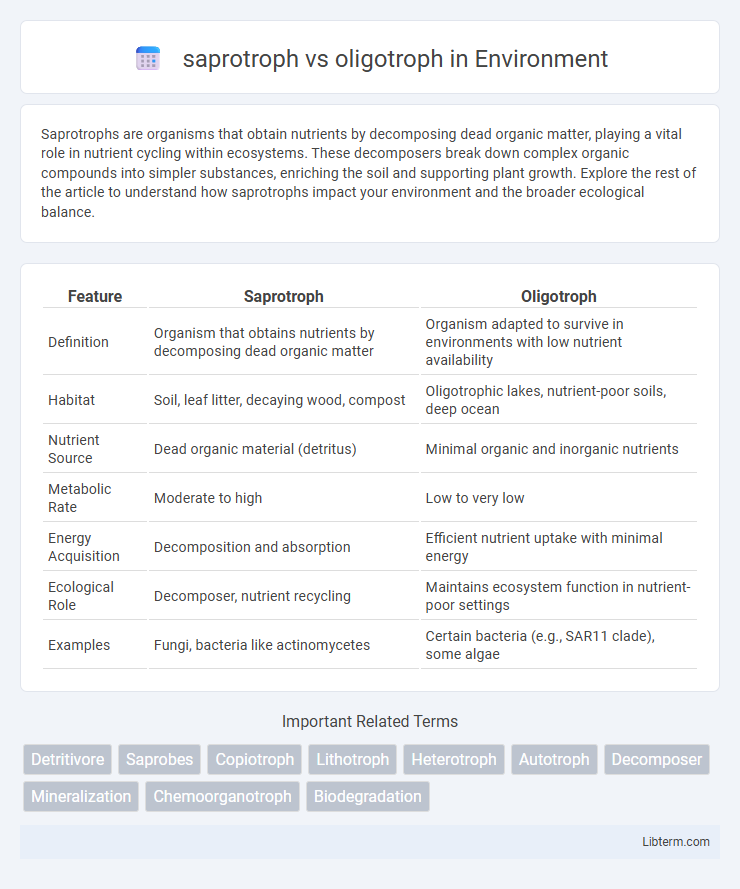Saprotrophs are organisms that obtain nutrients by decomposing dead organic matter, playing a vital role in nutrient cycling within ecosystems. These decomposers break down complex organic compounds into simpler substances, enriching the soil and supporting plant growth. Explore the rest of the article to understand how saprotrophs impact your environment and the broader ecological balance.
Table of Comparison
| Feature | Saprotroph | Oligotroph |
|---|---|---|
| Definition | Organism that obtains nutrients by decomposing dead organic matter | Organism adapted to survive in environments with low nutrient availability |
| Habitat | Soil, leaf litter, decaying wood, compost | Oligotrophic lakes, nutrient-poor soils, deep ocean |
| Nutrient Source | Dead organic material (detritus) | Minimal organic and inorganic nutrients |
| Metabolic Rate | Moderate to high | Low to very low |
| Energy Acquisition | Decomposition and absorption | Efficient nutrient uptake with minimal energy |
| Ecological Role | Decomposer, nutrient recycling | Maintains ecosystem function in nutrient-poor settings |
| Examples | Fungi, bacteria like actinomycetes | Certain bacteria (e.g., SAR11 clade), some algae |
Introduction to Saprotrophs and Oligotrophs
Saprotrophs are organisms that obtain nutrients by decomposing dead organic matter through enzymatic breakdown, playing a critical role in nutrient cycling within ecosystems. Oligotrophs thrive in environments with low nutrient availability, adapting to scarce resources by slow growth rates and efficient nutrient uptake mechanisms. Both saprotrophs and oligotrophs contribute to ecosystem stability by recycling nutrients and maintaining biological productivity under varying environmental conditions.
Defining Saprotrophs: Role and Characteristics
Saprotrophs are organisms, primarily fungi and bacteria, that obtain nutrients by decomposing dead organic matter, playing a critical role in nutrient cycling within ecosystems. They secrete enzymes that break down complex organic compounds into simpler substances, facilitating soil fertility and organic matter recycling. Unlike oligotrophs, which thrive in nutrient-poor environments by efficiently utilizing scarce resources, saprotrophs depend on abundant organic material for their metabolic processes.
Understanding Oligotrophs: Key Features
Oligotrophs thrive in nutrient-poor environments by exhibiting slow metabolic rates and efficient nutrient uptake mechanisms, enabling survival with limited resources. These organisms often possess specialized enzymes and membrane transport systems that facilitate absorption of scarce nutrients, distinguishing them from saprotrophs, which rely on decomposing organic matter for carbon and energy. Understanding oligotrophs' adaptations offers insights into microbial ecology and nutrient cycling in oligotrophic habitats like deep oceans and nutrient-deficient soils.
Nutritional Strategies: Saprotrophs vs. Oligotrophs
Saprotrophs obtain nutrients by decomposing dead organic matter, utilizing extracellular enzymes to break down complex compounds into absorbable forms, playing a crucial role in nutrient cycling. Oligotrophs thrive in nutrient-poor environments by efficiently assimilating scarce resources and often exhibit slow growth rates and metabolic flexibility to adapt to limited nutrient availability. These distinct nutritional strategies highlight saprotrophs' role in ecosystem decomposition and oligotrophs' adaptation to oligotrophic habitats with minimal nutrient levels.
Environmental Habitats and Adaptations
Saprotrophs thrive in nutrient-rich environments such as decaying organic matter, where they secrete enzymes to decompose complex compounds and recycle nutrients. Oligotrophs are adapted to nutrient-poor habitats like deep ocean zones or barren soils, exhibiting slow growth and efficient nutrient uptake mechanisms to survive under limited resource conditions. Both organisms display specialized metabolic pathways that optimize their survival and ecological roles within their distinct environmental niches.
Energy Sources and Metabolic Pathways
Saprotrophs derive energy by decomposing dead organic matter through heterotrophic metabolic pathways like aerobic respiration and fermentation, enabling nutrient recycling in ecosystems. Oligotrophs adapt to low-nutrient environments by efficiently utilizing limited organic or inorganic substrates, often relying on slow-growth metabolic pathways such as chemoautotrophy or low-rate respiration. The contrasting energy acquisition strategies reflect their ecological niches: saprotrophs exploit abundant organic material, while oligotrophs optimize energy extraction from scarce resources.
Ecological Impact and Significance
Saprotrophs play a crucial ecological role by decomposing dead organic matter, recycling nutrients, and maintaining soil fertility, which supports plant growth and ecosystem productivity. Oligotrophs thrive in nutrient-poor environments and contribute to ecosystem stability by efficiently utilizing scarce resources, thus sustaining microbial diversity and nutrient cycling in oligotrophic habitats such as deep oceans and arid soils. Both groups are essential for nutrient dynamics, ecosystem resilience, and the balance of biogeochemical processes in various ecological niches.
Examples of Saprotrophic and Oligotrophic Organisms
Saprotrophic organisms, such as fungi like Aspergillus and bacteria like Bacillus subtilis, obtain nutrients by decomposing dead organic matter, playing a crucial role in nutrient cycling. Oligotrophic organisms, including bacteria like Prochlorococcus and certain algae such as Nitzschia, thrive in environments with low nutrient concentrations, efficiently utilizing scarce resources for growth. These ecological adaptations highlight saprotrophs' role in organic matter breakdown versus oligotrophs' specialization in nutrient-poor habitats.
Comparative Analysis: Advantages and Limitations
Saprotrophs efficiently decompose organic matter, recycling nutrients and supporting ecosystem productivity, but their activity depends on the availability of dead organic material and suitable environmental conditions. Oligotrophs thrive in nutrient-poor habitats by utilizing minimal resources and exhibiting slow growth rates, which enables survival in harsh environments but limits rapid biomass accumulation. The comparative analysis reveals saprotrophs excel in nutrient-rich contexts with quick turnover, while oligotrophs dominate in oligotrophic ecosystems with resource scarcity, highlighting adaptive trade-offs in metabolic strategies.
Conclusion: Key Differences and Ecological Roles
Saprotrophs decompose dead organic matter, recycling nutrients and supporting ecosystem nutrient cycles, while oligotrophs thrive in nutrient-poor environments by efficiently utilizing limited resources. The key distinction lies in saprotrophs' role in organic matter breakdown versus oligotrophs' adaptation to low-nutrient conditions, influencing ecosystem productivity and species diversity. Understanding these differences highlights their complementary ecological roles in maintaining soil health and ecosystem stability.
saprotroph Infographic

 libterm.com
libterm.com